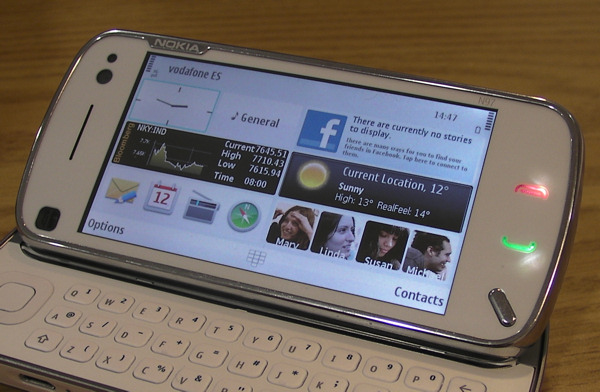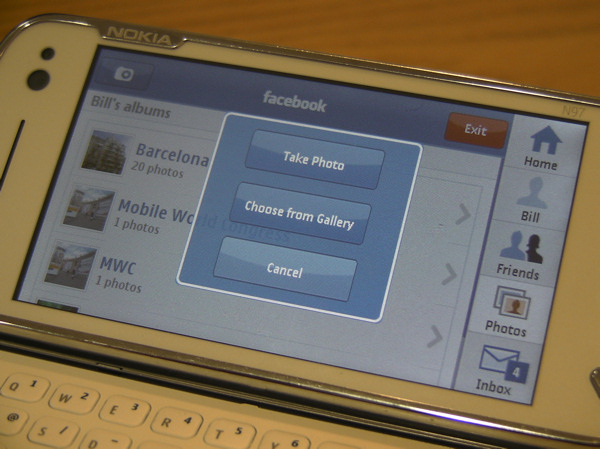N97 homescreen - widgets and customisation
A key element of the N97 is its customisable, widget-powered homescreen, as shown below. At the launch, at Nokia World in December last year, this was talked about in a generic sense, but the example widgets I saw were relatively limited and based around the in-built applications (e.g. contact bar, application shortcut bar, email summary information). It was difficult to fully appreciate their significance. While I was impressed by the N97's hardware at Nokia World, the immaturity of the software was clear, and consequently it was difficult to draw strong conclusions about the device.
Seeing the N97 at MWC, with a more recent software version, was something of a revelation. As you would expect, the software was very much more stable and the device's overall performance was much faster. However what stood out most for me were the homescreen widgets, which were closer to the 'vision' that had been talked about at Nokia World. I came away with a better appreciation of how important they are to device's overall experience.
The eye candy of the customisation options (e.g. the ability to drag and drop the widgets around the screen to customise their position) was shown off (the necessary 'bling' factor). The example widgets showed how summary information could be 'floated' on to the homescreen and able to act as jumping off point for various tasks.

N97 homescreen with space for six widgets.
Homescreen widgets can be written using S60's Web Runtime. A forthcoming version of WRT (1.1) will include support for creation of a homescreen portion of a WRT widget. Homescreen widgets can also be written in Flash Lite or C++, further details will be made available on the Forum Nokia site in due course. This means the widgets are effectively 'mini-applications' running within the confines of a pre-defined box on the N97's homescreen, but with full access to the device's functionality through the standard APIs.
It is likely we'll see a lot of 'mash-ups' or widget versions of popular social networks; for example, at MWC, Nokia were demoing widgets for Facebook, MySpace and LinkedIn. Other widgets, also being demoed at MWC, included Bloomberg and Accuweather; these form a separate category revolving around the display of summary information from the web.

N97 Facebook widget: gives access to notifications, messages and photos.
Integrates with phone features, such as the camera.
I spoke to several developers who were planning to take advantage of the functionality to provide summary information on the homescreen - some from the web, as above, but also from local applications. On existing Nokia devices, the customisable homescreen (Active Idle/Standby) has been a closed system (the preserve of Nokia plug-ins, such as search, email, music, Share online, and so on), but with the N97 this space will be much more open to third parties.
The new homescreen format will be used on future Nokia devices too; the N97 is a pioneer of the concept because its market position has the most to gain from it. In its launch press release, Nokia said the N97 was designed to 'transform the way people connect to the Internet and to each other' and 'for the needs of Internet-savvy consumers'. The customised, widget-based, homescreen is the core component of this vision.
For many consumers, the homescreen will be the primary point from which they interact with the N97. Its more task-based (or experience-based) approach stands in contrast to S60's traditional application-centric approach. Of course, the traditional S60 application launcher will still be present, but, for many, it will no longer be the key jumping off point for using their phone.
Nokia have already tried to do this with the multimedia menu in recent Nseries devices. This met with limited success (closed system, not customisable) and it is notable that this is, with its accompanying key, missing from both the N97 and the N86. The new homescreen can be thought of as a version 2.0, combing both the multimedia menu and active idle screen.
Much will depend on how many widgets are developed, and which widgets ship with the device - pre-loading Facebook, MySpace and other well known brands would give an immediate boost. How easy it is to download and install new widgets and communicating to consumers the new functionality and its advantages, will also be important. The Ovi Store, operators and marketing campaigns will all have important roles to play. There's an element of wait and see, but I do think the signs are very promising.
Kinetic scrolling (also known as flick scrolling)
In our Nokia 5800 coverage, we have noted that (in terms of user experience, at least) the S60 5th Edition web browser does not measure up to Safari on the iPhone. For the 5800, this was less of an issue given the different target markets, but the same would not be true of the N97. One of the major differences is the ease of moving around web pages. Kinetic scrolling, where you 'flick' on the screen to start scrolling, makes it much easier to move around larger pages.
Support for kinetic scrolling, by no means a minor piece of software engineering, has now been added to the browser on the N97. I only saw a brief demo of this, but it is clear that it makes a significant difference to the overall browsing experience. The 'double tap' to zoom in and out of a page has also been improved, and the browser's overall performance certainly benefits from being running on better specified hardware. With this in mind, the N97, given that it will also use a 'tip of the tree' (i.e. recent) version of the WebKit rendering engine, should be able to provide a compelling browsing experience. Adding in a full QWERTY keyboard, for data entry, and a D-pad, for accurate scrolling adjustments, will not hurt either.
I would also hope we see the updated browser added to the 5800 in a future firmware upgrade.
Video and concluding thoughts
Here's a video demonstrating the widgets and kinetic scrolling (last 30 seconds):
Incidentally, the demo units at MWC varied in quality. The one I saw had the most recent software update and a more recent hardware build. Some of the demo units on the stand appeared to be running an earlier software version. There was enough of a difference that people's perception of the N97 could be affected. This just underlines how significant software has become to the overall 'experience' of a device. It's also one of the reasons we've held off on bringing you a N97 preview - though you should start to see more coverage in a month or so.
Rafe Blandford, All About Symbian, 5 March 2009
